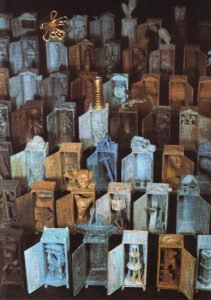The exhibition room was plunged into darkness for the duration of Maurice Owen’s exhibition, Burial, shown throughout the summer of 1999.

Clichés are the Armature of the Absolute, 1999, Maurice Owen
It was a reflection of, as the Hampstead and Highgate Express reported: “the battle between light and dark, life and death and the transition between the two.” The same article goes further to interpret Professor Owen’s work:
“Maurice Owen has gone straight into the heart of darkness…Owen’s installation and Freud’s comparison between archaeology and psychoanalysis sit well together here – it is the ideal spot for his work. Owen declares an interest in the relationship between contemporary art, archaeology and psychoanalysis…His interest in the idea is nothing new, the contemporary art didn’t spring fully formed out of the notebooks of Marcel Duchamp is also alluded to in the juxtaposition of his bronzes, the objects from the collection, and the modern knick-knacks“
Visitors were invited to take a torch and uncover the mysteries displayed in the dark interior. The torches dimly lit the room, softening the gloom, and in their beam groups of bronzes could be discerned, interspersed with objects from Freud’s collection of antiquities.
The artist researches into the work of Picasso, Giorgio de Chirico and Pompeian art inspired these sculptures and their groupings. In one part of the case were clustered a series called Stele, small cast bronze columns and pediments framing an extraordinary diversity of objects; some representing myth, some everyday items such as an armchair. Other sculptures were strategically placed throughout the Museum.
Maurice Owen wrote for an exhibition held in Venice in 1995: “The link between an artist’s personal life and their art production has to a large extent become all too transparent in the twentieth century. Hence it is very tempting to indulge in what the psychoanalysts call the ‘pathographic’ approach to art analysis and to place the artist’s life in direct causal relationship with their work. However, we are not psychoanalysts but artists and as such place the work of art at the centre of our investigations. But at the same time in a post-structuralist world we recognise that no work of art is sui generis, but is instead part of a complex web of implicit and explicit meanings, further complicated by cultural (including political) appropriation.”